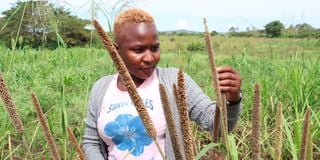Farmer relishes move to produce own dairy feed

Sheila Okoth inspects her fodder farm in Rangwena, Homa Bay County, on December 1, 2022.
When Sheila Okoth transitioned from teaching to dairy farming five years ago, she did not anticipate coming across challenges faced in milk production.
At her home in Rang’wena village, Homa Bay sub-county, she realised that her greatest challenge was the high cost of feed. That is when she decided to produce her own. As a teacher at a private school, she says, her salary could not address her needs. “I decided to down the chalk and start a family business of milk production, which I had a passion for,” Ms Okoth says.
She has eight daily cows that produce up to 100 litres of milk that is supplied to shops in Homa Bay town daily, with some bought by individuals at the farm.
When Ms Okoth began the venture, she was not recording optimum profit as she spent most of the money generated on feed—hay, Napier grass and other forms of fodder. “According to my calculations, my animals consume a pickup-full of Napier grass in two days for optimum milk production. This is besides other supplements,” she says.
At the local market, the grass is sold at Sh4,000 and delivered to the doorstep on a pick-up truck. One of the measures Ms Okoth took to reduce feed expenses was to supplement Napier with other forms of fodder, but it was still expensive for her to feed her cows. So sometimes she would buy vegetables when their demand was low and traders were selling at throwaway prices. But even that was not enough.
She had to look for better ways of increasing her earnings by spending less on production. Several ideas came to mind. One is working out perfectly one year on and she advises other dairy farmers faced with the same challenge to take their cue from her.
A few kilometres from the farm is a two-acre field where she has grown four different types of grass which she uses to feed her daily cows.
Initial capital
The land is located at the edge of River Arujo in Kalanya Kanyango location and it is never dry because of the constant water supply. Ms Okoth says grass production has turned around her fortunes as she no longer spends much on feed. “All that I needed was capital to purchase the land. I got support from my husband who gave me Sh1.2 million to buy it as a long-term measure in cutting the cost of production.”
She started planting fodder in mid-2021 after being trained by experts at International Centre of Insect Physiology and Ecology (Icipe) in Mbita town. It is turning out to be the best solution to her problems, as she now laughs all the way to the bank. The feed Ms Okoth produces includes Napier grass, brachiaria, Boma Rhodes and sugar blaze.
At the farm, where she has employed one person, different grass is grown in one section. For Napier, holes were dug 30-centimetre deep and half a metre apart. Rows are also half a metre apart.
When planting, a farmer can use harvested canes, which are put in the hole while leaving the node exposed on the surface. Ms Okoth got her canes from a neighbouring farm for free.
“Another method of propagation is the use of Napier splits whose leaves are trimmed. Once the crop is planted, the soil is covered and firmed in,” she says.
The Napier grass is cut two to three months after planting—the time when its nutritional contents are high.
“The grass is chopped into small pieces using a machete. Farmers practising large-scale milk production use machines,” Ms Okoth says.
Napier grass is now the main feed for her animals. Brachiaria is another major fodder at the farm. It has a high production capacity of biomass, hence providing a good alternative for making silage and hay to be used during drought.
Okoth says it grows the same way as Napier. Sprouts are put in holes and covered with soil. It takes four months to mature and between six and seven months after the first harvest. “Brachiaria is good in protein in comparison to other grasses. It ensures milk production is at the highest level,” Okoth says.
Boma Rhodes
Recently, she introduced Boma Rhodes and expects to start cutting them this month. To produce the grass, Okoth bought seeds from an agrovet, which she broadcast in the field. “I intend to make hay using the grass,” she says.
National Agricultural and Rural Inclusive Growth Project coordinator Erick Adel says fodder farming is becoming popular in Homa Bay with some growers doing it commercially.
“It is one of the major sources of income today,” he says.
According to Adel, fodder makes good use of the land as it covers the soil to reduce moisture loss. He says weeding is also minimal.
The Narigp officer says the nutritional value of fodder which determines milk production depends on mater contest and crude protein content.
"There are different stages of harvesting fodder. It should be harvested at the right time," Adel says.
Despite the benefits of producing its feeds, the venture comes with its own sets of challenges.
Okoth says she has from time to time asked neighbours to send away their animals when they invade her farm. A solution to this problem is facing the farm. During dry seasons, the feeds can easily wither.
But despite the farm located near a river which promotes irrigation, pumping water is expensive as it requires the use of a generator that consumes fuel.





